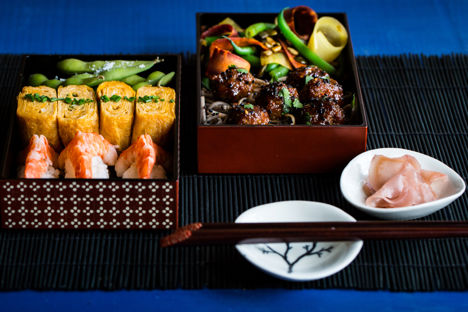
Flavours of Japan: bento
Louise Robinson takes us through the exciting history of bento – the traditional Japanese lunch boxes that have blossomed into something of an art form. Read on for helpful tips for making your own bento boxes at home.
View more from this series:
Flavours of JapanJapanese bento boxes may have recently become a popular form of ‘packed lunch’ all over the world, but they actually have a rich and culturally significant history in Japan going back hundreds of years. Said to have been invented by the Samurai, who developed foods that were easy to transport, their use can be traced as far back as the twelfth century. It was during Japan’s Kamakura period that dried meals or hoshi-ii were first introduced and packed lunches consisting mainly of dried rice were carried when out hunting or working in the fields. Bento at this time was little more than a small bag to store rice which could be rehydrated with hot or cold water, or eaten as is. Wooden lacquered bento boxes were not seen until much later, but they were mainly used for tea parties, cherry blossom viewings and other such gatherings.
It was not until the seventeenth century that the use of bento boxes became more refined and widespread. They started to be used for home entertaining and prepared for travelling. It would have been common to take a fancy tiered bento box with an assortment of food on a picnic or other excursions. Theatregoers would take Makunouchi (‘between-scene’) bento filled with ongigri rice balls sprinkled with sesame seeds to enjoy during intermissions. For other outings, they would also typically include seafood, pickles, rice and bamboo shoots. Bento boxes started to develop into an elaborate art form.
The arrival of the Japanese Railway system in the nineteenth century, saw bento boxes being sold at train stations. Called Ekiben (‘station bento’), they usually contained pickled daikon radish and rice balls wrapped in bamboo with pickled umeboshi. European style Ekiben started to become available at railway stations, with sandwiches instead of rice balls.
With the advent of World War One, bento became a symbol of the disparity in the population due to the export boom and subsequent crop failures. They were seen as only affordable for the wealthy. Bento boxes taken to school by children were considered a measure of their family’s wealth, which led to the practice of them being abolished in favour of school dinners. Aluminium boxes were introduced at this time, but there was a dramatic decline in the use and popularity of bento overall.
The 1980s saw a resurgence in the use of bento boxes with the introduction of microwaves and they became popular again. They are now a common sight in schools and at work with ready-made bento boxes available at bento shops, supermarkets, department stores and restaurants. The boxes themselves are now made of everything, from traditional wood to plastic, and can be found in many shapes and sizes.
A new craze started in the early 1990s when mothers started to design the contents of their children’s school bento boxes to look like cute cartoon characters – Kyaraben (‘character bento’) was born! This is now a serious art form with international competitions for the best bento featuring cartoons, celebrities, animals or famous artworks.
Bento boxes may be considered food art, but making them at home can be as simple or elaborate as you wish. Most boxes consist of a main and two to three side dishes. Main courses are usually chicken, meat or fish based, along with vegetable or salad sides. Rice is almost always present as a side dish, but can be substituted with bread or pasta if you are going for a more European-style box. Think about colour and texture, as a traditional bento is always designed to be visually appealing and appetising! The main rule when considering what to include in your bento is that the food should be portable and ready to eat.
A simple bento box could include dishes such as steak teriyaki, Japanese rice with spring onion and ginger, baked aubergine with miso and pickled cucumber. If you are a vegetarian you could substitute the meat with tofu or bean-based dishes. Any gaps can always be filled with boiled eggs, pickles and simple salads.
If you are feeling a little more adventurous, try adding edamame beans with soy sauce, prawn nigiri, Japanese omelette, sesame and ginger pork meatballs with soba noodles and a carrot and green bean salad. Do not forget to include pickles, soy sauce and wasabi for dipping.
For a really special occasion, pull out all the stops with crab or prawn crystal rolls, fresh tuna sashimi, salmon and avocado or vegetable maki, chicken with yuzu and sesame and fresh cucumber and spring salad. If you do not feel confident making your own sushi, you could always add some shop-bought pieces, but it is easier than you may think to prepare.
Be inspired by seasonal food – consider adding leftovers or trying something completely different, like a European-style box filled with pasta antipasti. Above all, make your bento box your own and don't be afraid to experiment, especially if you have lots of time or it is a special occasion!

